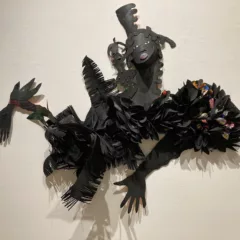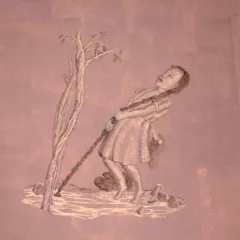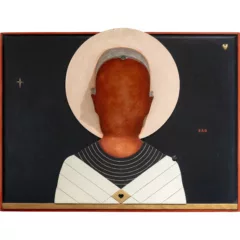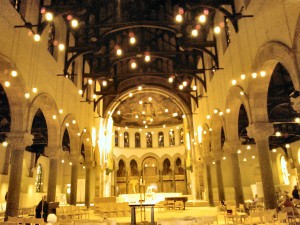
Transformations, curated by Anne Minich, features inventive works on paper by six artists. The show, at the stunning Episcopal Cathedral — whose high-vaulted ceilings and warm, ambient light provide an excellent venue for the project — presents the viewer with a process-centered take on works on paper.
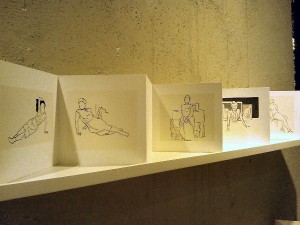
Ditta Baron Hoeber’s handmade paper books show a progression of simple, small-scale line drawings. The series is unframed, and the individual pieces resemble studies. In her statement, the artist explains that working with the same model over time results in a process of “culling and sequencing.” This repetitive process is significant as Baron Hoeber’s focus is on the process of making art and the intermingling of this process with the life and person of the artist. Baron Hoeber juxtaposes these drawings with a more fully realized depiction of a woman at work. The effect is such that the line drawings seem to be still, while intensity and action resonate from the woman bent over her work.
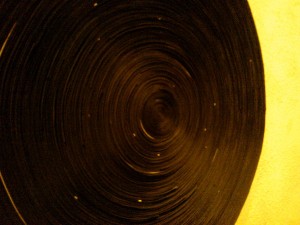
On your journey through the large space of the Cathedral, Marcy Hermansader’s mysterious paper collages (if collages they can be called) follow Baron Hoeber’s works nicely. “Back through the stars” is composed of strips of black paper, spiraled and glued around one another. The black hue is almost palpable, while the texture of the paper adds visual depth and thickness, almost weight. Streaks of silver highlight the monochromatic lines of the piece, referencing stars whizzing past at high speed. Much like stargazing, the effect is mesmerizing and instantly evocative of thoughts of the unknown and the infinite. These calming works encourage a reflective quiet, which I truly appreciate.
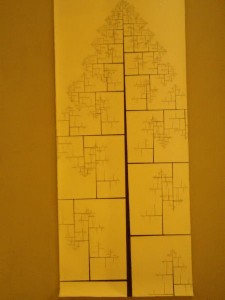
Bruce Pollock’s site-specific scroll fuses geometric and natural image, a nice transition from the decidedly organic pieces by Hermansader and Baron Hoeber. Interested in fractals for their endless possible permutations, Pollock states that circles and polygons form the cornerstone of his recent work. The notion of the infinite contained within the finite limits of two-dimensional representation is an interesting play of concepts. His scroll depicts a tree-like form that visually references genealogical diagrams, suggesting a sort of established course or flow.
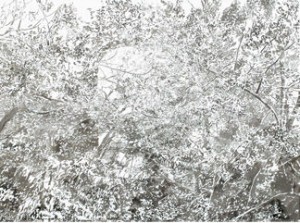
Incorporating old and new, works by Emily Brown and Susan Hambleton’s play nicely off of each other. Brown brought incomplete, saved works to new life in her ink drawings. These works felt very close and personal, as though a friend had shown me a sketchbook, which she has shown to no one else. The pieces that utilized her old works suggest growth with the passing of time, necessary for art to continue. “Closer,” an extremely close view of leaves of grass, was especially intimate and expressive of a desire to know the subject better. Not just to draw, but also to see.
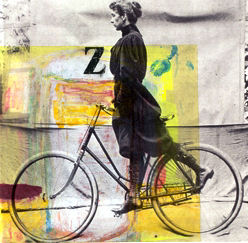
Susan Hambleton nods to the printing press with her use of photographic collage layered with monoprint drawings. “Hold Still 23” depicts a woman dressed in Victorian style standing on a bicycle, with a letter “Z” in bold type by her chest. This moment of encapsulated tension (the woman about to take off on her bike) seems to point to the intellectual explosion caused by the introduction of the printing press into society. Another work, “Orange” shows a reclining female form bathed in orange light, accentuating the sensuality of the pose and referencing the warmth of skin.
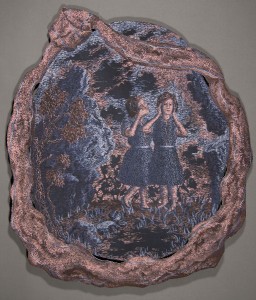
The intricate, narrative drawings of Marilyn Holsing closely resemble pointillism in their rendering. The strokes of the pen are so precise that the visual effect results in something like extravagant, textured tapestry. Holsing presents the viewer with an imaginary vignette of the life of a young girl. In “Marilyn Thwarted,” two young girls stand amidst a lavish landscape, presumably moments after a youthful prank of which Marilyn is on the receiving end, her face in her hands in a pose of defeat. These drawings remind me of Grimm’s Fairy tales, at once lively and serious. The title suggests a level of self-reflection of the artist implicit of personal growth.
Transformations will be on display at the Episcopal Cathedral in the University City section of Philadelphia until Sunday, September 30. More information can be found by visiting their website.



